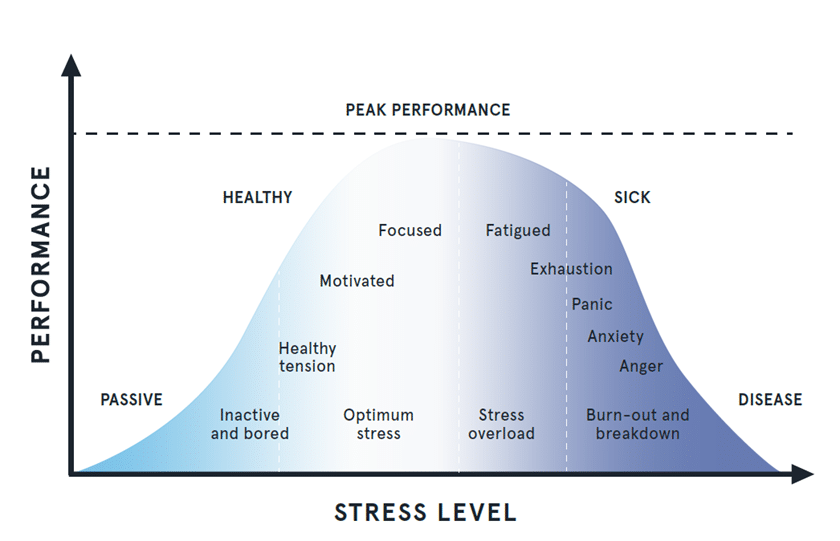Stress is a universal human experience. While a moderate amount of stress is important for our growth, learning, and adaptation, stress is generally seen as an experience to be avoided. This is because we are more aware of stress when it becomes too much to handle.
As health and wellness coaches, you are likely aware of your clients’ stress levels and how these impact their overall wellbeing. When speaking to your clients about stress, it can be helpful to talk about specific effects of stress on aspects of their mental and physical health, such as their mood and energy levels.
This article discusses ten different ways stress impacts our mood and energy levels, and it provides concrete resources for supporting your client in managing stress.
What Is Stress, Exactly?
Stress is the word we commonly use to refer to the feeling we get when our bodies experience a stress response. The stress response is the way our bodies respond to a stressor. Stressors can include things like a deadline, uncertainty, a perceived threat, unexpected changes, health risks, divorce or separations, and countless others.
Stress can be categorized in different ways; it can be categorized as the location of stress in the body or the length of time a person experiences stress.
With regards to the location of stress, the two primary types of stress are psychosocial (mental) stress and physiological (physical) stress.
- Physiological stress, or physical stress, refers to an unpleasant or painful experience associated with potential damage of the body tissue or a threat to your life. Conditions like pain, hunger, and oxidative stress caused by exposure to toxins are causes of physiological stress. Depending on our awareness of physiological stress and its impact on our health, it can also cause psychosocial stress.
- Psychosocial stress, also known as mental or emotional stress, results from situations of social threat, like social exclusion, stress related to achievement, negative emotions, and goal-oriented performance. If psychosocial needs aren’t met, psychosocial stress can result. Often, this is referred to as anxiety.
The other way to categorize stress is by the length of time it is present.
- Acute stress is short-term stress and lasts a couple of hours to a few days. This type of stress is normal, and an essential experience for humans and other living beings to identify new or risky situations, respond in the best way possible, and learn from the experience.
- Chronic stress is stress that lasts several weeks or months. In this state, levels of the stress hormone, cortisol, are constantly high, which has numerous negative effects on the body and mind. Chronic stress is commonly experienced as a result of trauma and adverse childhood events.
You can read more about the science of the stress response here.
Learn How to Become a Certified Holistic Health Coach Online

The Relationship Between Stress Level and Health
What is important to note is that the intensity of the stress response, regardless of the length of time it is experienced, can negatively affect your mental and physical state. Intense stress can make you feel flustered, unable to react, and fatigued, even if it is experienced for a few minutes or hours.
If intense stress levels are felt for long periods of time, it can increase the risk of disease development.
The Yerkes-Dodson Law describes the inverted U-shaped relationship between performance and stress levels. With low to moderate stress levels, performance improves. When stress levels are too high to manage, performance decreases. Chronic physiological or psychological stress can result in burnout and disease.

How is stress related to disease? High-stress levels dysregulate the immune system. It may overreact when it should not, causing the development of autoimmune disease, and it may not protect your body from pathogenic viruses and bacteria. The result of both is illness.
The impact chronic stress can have on illness and disease is worrisome, but generally, we are more aware of our day-to-day mood and energy levels. We want each day to be productive, we want to have energy levels that allow us to complete daily activities, and we want to feel joyful or peaceful doing it.
As mentioned before and as described in the graphic above, moderate levels of stress can improve our health and wellbeing. The term for this is eustress. It helps us feel motivated and focused, and it is often when creativity and problem-solving abilities peak.
However, if a person starts to experience stress overload, not only will their performance level decrease, so will their mood and energy levels. The person is no longer in eustress, but instead in distress.
5 Ways High Stress or Distress Impacts Your Mood
Below are five ways high emotional or mental stress can negatively impact mood:
- More emotional than usual: You may notice you are more sensitive or have less patience. Some people also have the opposite reaction and become stoic when they are in high-stress situations.
- Feeling overwhelmed: You may feel like you are unable to take action and that your feelings are big, front, and center. When you are overwhelmed, you may want to shut down completely, cry, or yell.
- Feeling on-edge: When you are under a lot of stress, your blood has high levels of cortisol. Your body and mind are in “fight or flight” mode. Naturally, this will make you feel on-edge, ready to react accordingly in the face of perceived danger, whether that be another assignment or something that distracts you from meeting a deadline.
- Feeling flustered or having a hard time keeping track of things: Your mind is focused on the cause of your stress, making it difficult to think of other responsibilities. You might find yourself making a sandwich while pausing to answer an email and tend to your child, and then forget where you left the bread for your sandwich.
- Feeling indecisive: This affects your ability to solve problems, concentrate, or get your work done.
5 Ways High Stress or Distress Impacts Your Energy Levels
Stress is experienced physically as well as mentally. The feeling of sustained or intense stress can have a notable impact on your energy levels. For many people, stress can make it difficult to stay alert during the day and difficult to sleep at night; the combination causes a cycle that impacts your sleep cycle, called your circadian rhythm.
Below are five ways distress can impact your energy levels.
- Heaviness in your chest, increased heart rate, or chest pain. This can make it difficult for you to carry out physical activities and exercise if you already accelerated before even starting.
- Tiredness during the day. If you are highly stressed, you may feel sleepy during the day, even when you are in the middle of an important task. Sleepiness can be your body’s way of giving itself a break, even if you don’t intend to.
- Increased risk of depression. People who experience chronic stress are significantly more likely to experience depression. Depression can lead to inactivity and a lack of desire to stay active.
- Frequent lethargy. Short bouts of stress, or moderate levels of stress, often boost your energy levels. However, if you experience sustained stress or chronic stress, you are more likely to feel lethargic, wanting to stay inactive or “lazy” most of the day.
- Fatigue: A recent study that involved more than 7,000 working adults found that work-related stress was significantly associated with fatigue. Fatigue is physical tiredness, regardless of the activities you have carried out. You might feel like you are recuperating from running a marathon, even if you haven’t been active for several days or weeks.
Resources to Help You and Your Clients Manage Stress
Below is a list of AFPA and non-AFPA resources you can use to support your clients in managing stress.
- 6 Healthy Ways to Help Your Clients Cope with Stress & Anxiety by AFPA
- Stress Relieving Techniques by AFPA (with infographic)
- Yoga for Stress Relief: Three Mood-Brightening Poses by AFPA
- How Childhood Adversity Affects Our Bodies & Why It’s Important for Health & Wellness Professionals by AFPA
- How to Support Your Clients’ Holistic Health Through Holiday Stress and Traumaversaries by AFPA
- Doing What Matters in Times of Stress: An Illustrated Guide by the World Health Organization. It is available in twenty-five languages.
Main Takeaways
Everyone’s stress threshold, or the amount of stress they see as manageable, differs. For example, people in highly stressful jobs, like emergency room doctors, military, or security personnel, may have developed a higher stress threshold out of necessity. At the same time, they are often more vulnerable to burnout and breakdown. You or your client may be experiencing significantly more stress due to personal circumstances, like financial stress, a breakup or divorce, losing a loved one, or a legal battle.
High stress, or distress, is common, but it does affect aspects of your health and wellbeing, such as your mood and energy levels. The good news is that there are ways to prevent some types of stress, as well as techniques to help manage stress so that it doesn’t become overwhelming. Save this article or share it with your client to gain a deeper understanding of stress and how it affects your well-being and find ways to manage it effectively.
By getting certified for yoga online with AFPA, you can gain a solid foundation in yoga principles and techniques, as well as practical experience teaching and leading classes.
References:
- https://www.ncbi.nlm.nih.gov/pmc/articles/PMC4564342/
- https://link.springer.com/referenceworkentry/10.1007%2F978-0-387-79948-3_1340
- https://www.ncbi.nlm.nih.gov/pmc/articles/PMC4264740/




